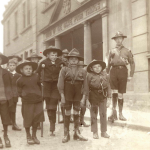In 2013, the University of the Third Age (U3A) carried out a study in collaboration with Langdon Down Museum “to augment its historical database on how Normansfield operated and the people it cared for.” History of Place has been granted permission through the generosity of U3A and Langdon Down Museum to reproduce some of the results of that research. This is the first of two case studies taken from the early years of Normansfield Hospital (1868-1913). The text below is taken directly from the U3A research pages of the Langdon Down Museum of Learning Disability website.
Ninety eight per cent of patients were admitted (to Normansfield Hospital) with a mental disorder listed as either idiocy or imbecility. Ida is interesting because she did not fall into either category. The Admission Register lists her mental disorder as nymphomania.
The Admission Register lists (Ida’s) mental disorder as nymphomania
Ida was admitted to Normansfield at the age of 16 at the instigation of her father on 6 July 1895 under a medical certificate of the same date. The following in italics is a copy of the text of the hand-written entry in “Report on Admission” (LMA ref: H29/NF/B/04/02).
“Ida Page was decidedly clever as a child. As soon as she began lessons showed no power of application. Has picked up for herself but cannot learn. Good at languages – can manage to speak almost any language. Has a natural gift for music. Good voice and can accompany herself. Very sharp and amusing. No sense of propriety. Mother died when she was six. Has had a series of governesses. Her maid (French) has most pernicious influence. Last year /94 became much less capable of doing any work. Up to the beginning of last year began to show more power of getting on. Spring /94 went to Cumberland for 3 or 4 months, improved there and derived good from her stay when she helped in household matters a little. Then, in April, when she came home, did very badly. In August her father married again and they went to Switzerland, and were positively driven out of hotels because of her very bad behaviour. In October was more disobedient and intractable and given to using bad language. When she went to Brighton her language was gross but, by Christmas, they stopped her bad habits and reformed her considerably. Was home a week and behaved well. Has resented being looked after, thinking she was going to come out. Appetite is good, especially for meat, which she eats very fast. Destructive of jewellery. Restless lately in bed, bath every evening.”
Apart from the comment “no sense of propriety”, there is no indication of any behaviour that would warrant the diagnosis of nymphomania
A reader today may well think this to be a description of a strong-willed, difficult teenager perhaps upset by the introduction of a new woman in her father’s life and who resented her becoming her step mother. Perhaps her father wanted some time alone with his new bride.
Apart from the comment “no sense of propriety”, there is no indication of any behaviour that would warrant the diagnosis of nymphomania. Is this then a case of the hospital bowing to the wishes of the parent without challenge and was Normansfield where Ida should have been?
There is no correspondence on file relating to Ida’s stay or her treatment and progress at Normansfield, but she did not stay long. She left on 3 March 1896 and was listed in the Discharge Register as condition “relieved” (not recovered).
Having read the above case study it would be difficult to conclude that it hardly portrays the hospital in a very flattering light. Under the stewardship of John Langdon Down, Normansfield became a centre of excellence in the study of learning disabilities. Ida Page was a resident in the last years of Langdon Down’s life, perhaps after his sons had taken a greater role in the running of the institution. Had Normansfield begun at this stage to resemble a more traditional Victorian asylum, a place to hide people who would not or could not conform to society’s norms, or was the treatment of Ida Page an aberration? Sadly we may never know.









